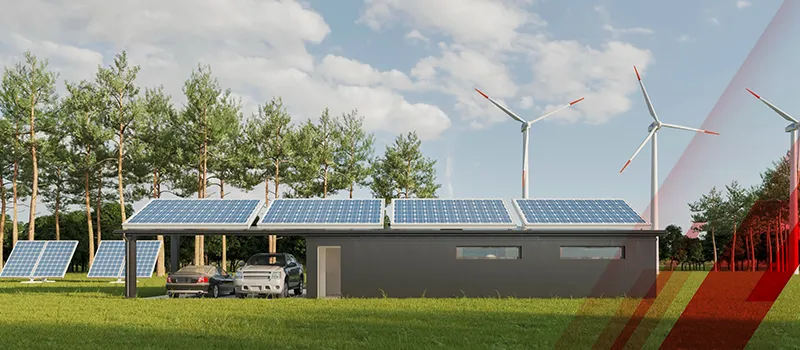Imagine a world where power outages are rare, energy consumption is optimized, and renewable energy seamlessly integrates into our daily lives. Have you wondered who is working silently behind the scenes? The answer lies in the smart grid, a revolutionary system that is transforming the way we generate, distribute, and consume electricity. In this era of smart technology, where phones, homes, and cars are getting smarter, it's about time our power grids caught up.
Let's dive into the world where efficiency, sustainability, and reliability reign supreme.
What is a Smart Grid?
A smart grid is an advanced network of electricity that employs digital technology and two-way communication to optimize the generation, distribution, and consumption of electricity.
With the emergence of smart energy grids, there has been a significant shift from conventional transformers to smart transformers. These innovative devices, including smart current transformers and smart LED transformers, provide enhanced monitoring and control capabilities.
These transformers are equipped with optical and digital sensors that enable real-time data analysis, fault detection, and self-healing capabilities, optimizing power flow and improving grid performance. Additionally, they provide precise current measurements, enabling efficient grid management. They play a pivotal role in regulating and controlling the power supplied to LED lighting systems, which are also crucial for energy-efficient lighting solutions.
With its ability to coordinate the needs and capabilities of various stakeholders, the smart grid is transforming the way we generate, distribute, and consume electricity, paving the way for a more sustainable and resilient energy future.
A recent study by Kings Research states that the global smart grid market is likely to reach USD 123.24 billion by 2030, growing at a compound annual growth rate (CAGR) of 13.57% from 2023 to 2030.
What Benefits Does Smart Grid Bring to the Energy Industry?
The benefits of a smart energy grid are numerous and impactful. Here are some key advantages:
- Increased Efficiency
Smart grids enable real-time monitoring and control of electricity usage, resulting in reduced energy waste and greater overall efficiency. Businesses can optimize the distribution network, minimize transmission losses, and avoid the need for additional infrastructure investment.
- Enhanced Reliability
Advanced sensors and automation technology in energy grids allow for quick identification and response to power disturbances, such as outages or voltage fluctuations. This leads to a reduced frequency and duration of power outages, ultimately increasing grid reliability.
- Integration of Renewable Energy
Smart energy grids facilitate the seamless integration of large-scale renewable energy systems. By efficiently managing the generation and consumption of renewable energy, smart electricity grids contribute to a more sustainable and environmentally friendly energy landscape.
- Lower Costs
These advanced grids can reduce operation and management costs for utilities, which can translate into lower power costs for consumers. Additionally, by reducing high demand and optimizing energy distribution, smart energy grids can help lower electricity rates.
- Improved Customer Experience
With smart energy grids, consumers gain access to real-time energy usage data. This empowers individuals to manage their energy consumption more efficiently.
- Grid Flexibility and Self-Healing
These grids have the ability to adapt to changing energy demands and automatically reroute power in case of failures or disruptions. This self-healing capability enhances grid resilience and ensures continuous electricity supply.
- Advanced Billing
These smart grids often incorporate smart billing options, which reduce energy theft and enable more precise billing based on actual consumption.
Top Trends in Smart Grid Electrifying the World of Energy
Listed below are the recent trends in smart energy grid systems that are significantly changing the energy sector.
- IoT Integration
IoT devices are integrated into energy grids to enable real-time monitoring and control, preventing energy theft and enabling remote control. This data collection simplifies grid asset monitoring and enables preventative maintenance.
Recently, Nigerian startup Switch introduced its prepaid smart meter for decentralized energy projects. It is equipped with advanced features like smart alerts, theft detection, and anomaly detection.
Likewise, US-based startup Verify Energy develops Powerfly, an IoT-based smart grid monitoring software for clean energy devices. The software allows clean energy providers to connect to the software, enabling two-way communication for asset managers to control clean energy assets through the cloud or locally.
- Microgrids
Microgrids have emerged as a groundbreaking trend in the field of energy generation and distribution. They work as decentralized energy generation and distribution sources for remote areas, utilizing renewable energy sources like solar, hydro, and wind power.
They reduce reliance on fossil fuels and provide backup power during grid outages, which is essential for hospitals and data centers. As technology advances at a rapid pace, numerous companies are making notable contributions to the field.
Startups such as Mavericks and Elektrifi Technologies are actively engaged in the development of microgrid systems. These systems are specially designed for urban applications, reducing strain on the main grid, improving energy demand response, reducing carbon emissions, and enhancing sustainability.
- Rise of EVs
The emergence of electric vehicles (EVs) is making a significant impact on advanced energy grids. EVs are being increasingly incorporated into smart energy grids to enhance demand response and optimize the distribution of power.
This integration enables EVs to supply electricity back to the grid during high demand, thereby reducing reliance on costly power plants. Recently, Bia, a Spanish startup, introduced an EV charging platform that maintains stations and provides data services, energy forecasting, and simulations for EV load modeling. Its optimized charging algorithm uses renewable sources, reducing power costs and smoothing peak loads.
The Future of Energy is Smart
The smart grid represents a remarkable leap forward in the world of energy management, promising a future that is more efficient, sustainable, and reliable. With its advanced technologies and smart components, this transformative system is poised to revolutionize the way we generate, distribute, and consume electricity.
As we continue to face the challenges of an ever-growing demand for electricity and the need to reduce our carbon footprint, the smart grid stands as a beacon of hope, offering a path towards a greener, more resilient energy future.




